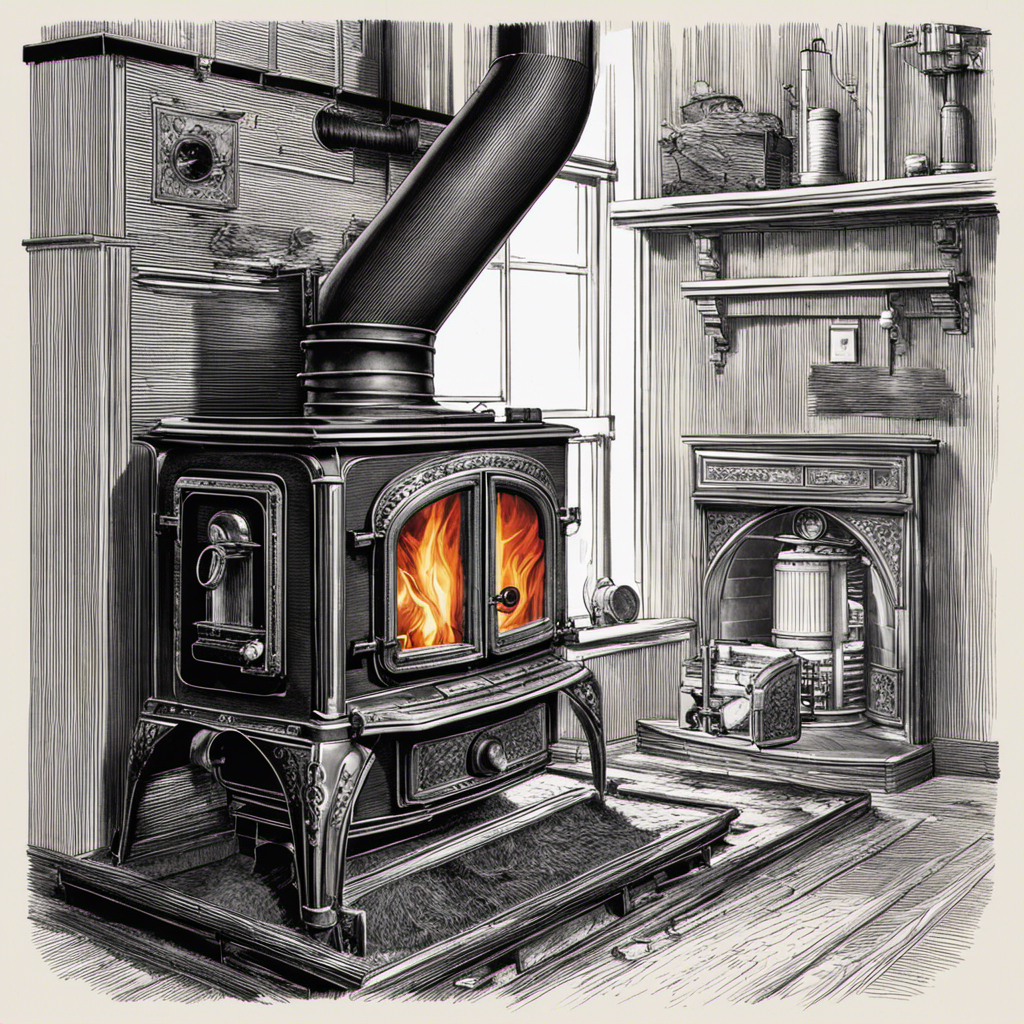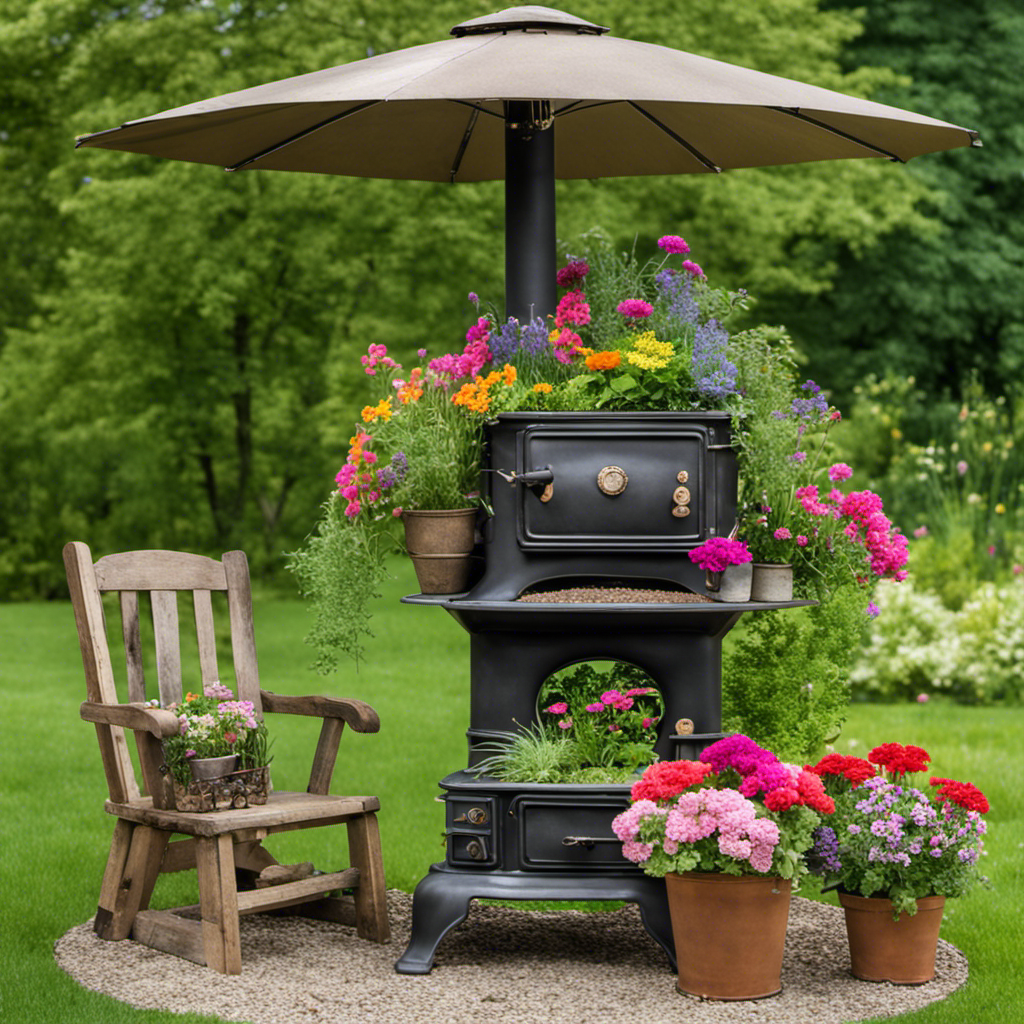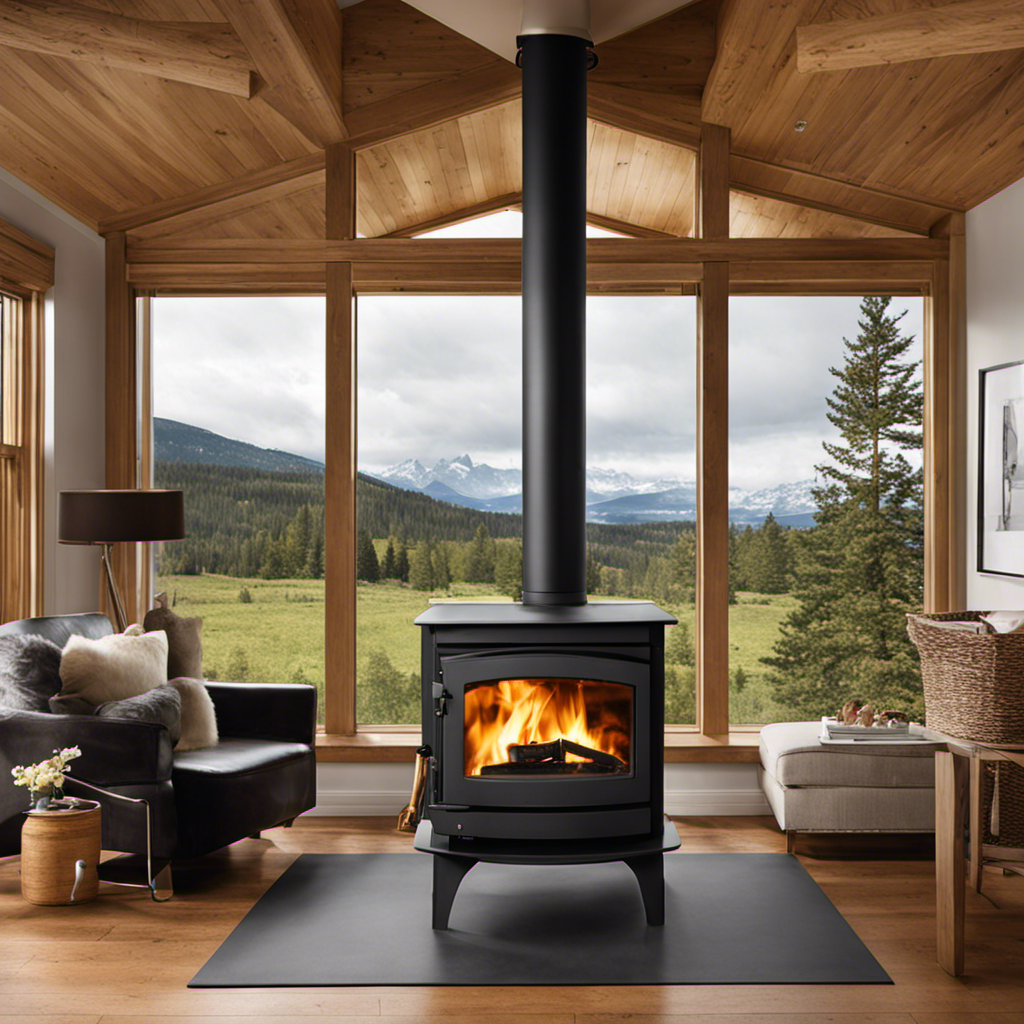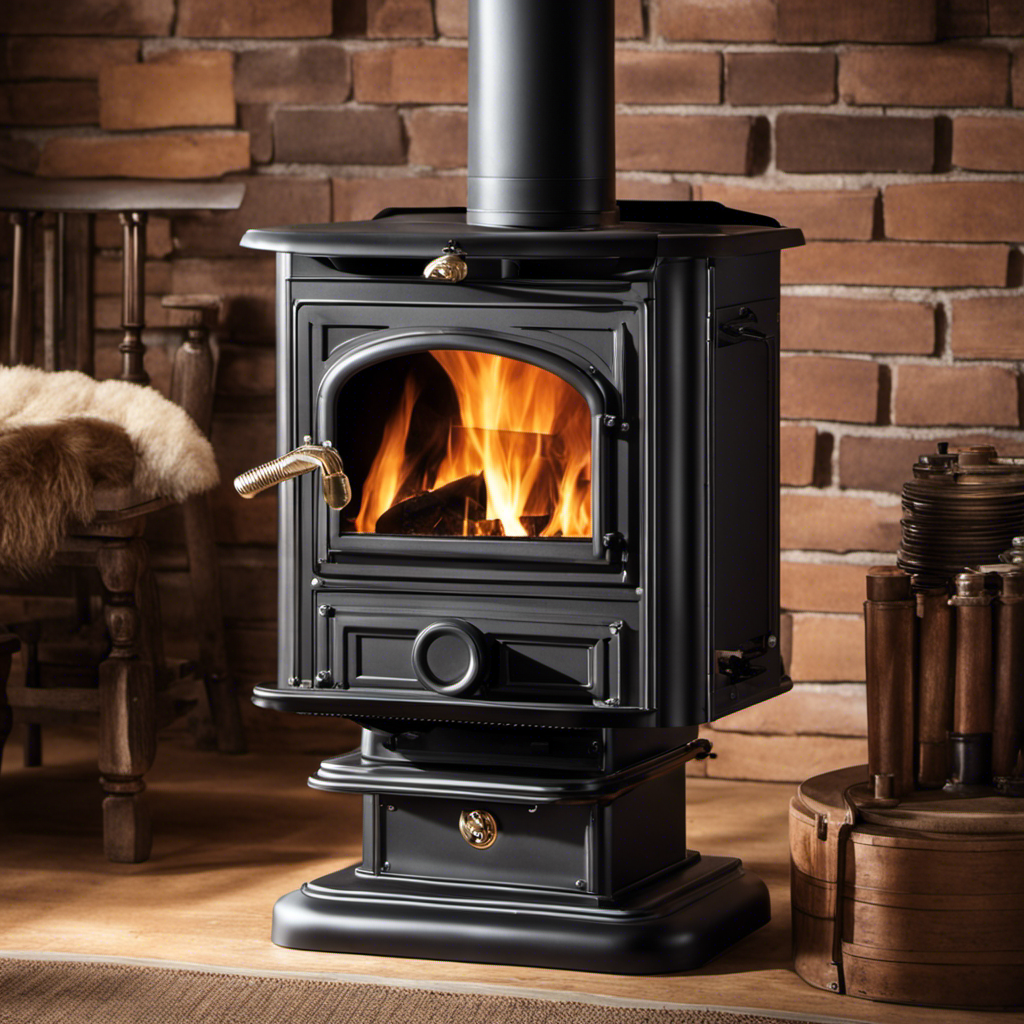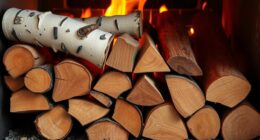I’m here to provide insight into the intriguing mechanics of a wood stove.
Ever wondered how this humble appliance magically warms up your home? Well, you’re in luck! In this article, I’ll break down the basics of wood stove design, delve into the combustion process, explore the different types of wood fuel, and discuss the crucial role of airflow in maximizing efficiency.
So grab a cup of tea and get ready to geek out on the science behind cozy warmth.
Key Takeaways
- Wood stoves are made of durable materials like cast iron or steel for heat retention and longevity.
- The combustion process involves different stages, and understanding and controlling these stages is essential for clean and efficient burning.
- Choosing the right type of wood, such as hardwood instead of softwood, and following proper wood burning techniques can increase efficiency.
- Proper airflow control, including air intake and secondary air, is crucial for optimal combustion efficiency and reducing emissions.
The Basics of Wood Stove Design
I find the basics of wood stove design fascinating. When it comes to wood stove maintenance and installation, understanding the design is crucial.
A wood stove consists of several key components that work together to provide efficient heat. The main structure of the stove is made of cast iron or steel, which allows for durability and heat retention.
The firebox, located inside the stove, is where the wood is burned. It’s designed with refractory bricks or plates to withstand high temperatures.
The baffle system, located above the firebox, helps to direct the flow of gases, ensuring complete combustion and maximum heat transfer.
The flue system, including the chimney, removes the by-products of combustion from the stove. It’s important to ensure proper installation of the flue system to prevent smoke leakage and maintain optimal performance.
Overall, the design of a wood stove is intricate, with each component playing a crucial role in its operation. Understanding the design is essential for efficient wood stove maintenance and installation.
Now, let’s delve into the next section about understanding the combustion process.
Understanding the Combustion Process
The combustion process in a wood stove is fascinating to understand. It involves a combination of chemistry, ignition, and combustion to produce heat and energy. To better grasp this process, let’s take a look at the different stages involved in burning wood.
| Stage | Temperature Range (°C) | Description |
|---|---|---|
| Pre-ignition | Room temperature | This is the stage before the wood is ignited. The wood is dry and contains volatile gases, such as methane and hydrogen. |
| Ignition | 200-300 | At this stage, the wood is heated to a temperature where the volatile gases are released and ignite. This creates a flame and initiates the combustion process. |
| Pyrolysis | 300-500 | During pyrolysis, the wood decomposes due to heat. The volatile gases continue to be released, and solid char is left behind. This char burns slowly and provides additional heat. |
| Combustion | 500-900 | In this stage, the volatile gases and char are burned. The heat released from the combustion process is what generates the majority of the heat output in a wood stove. |
Understanding the chemistry, ignition, and combustion processes involved in a wood stove allows us to appreciate the efficiency and effectiveness of this heating method. By controlling these stages, we can optimize the burning process and ensure a clean and sustainable source of heat.
Fueling a Wood Stove: Types of Wood and Best Practices
When it comes to fueling a wood stove, choosing the right types of wood and following best practices is crucial for optimal efficiency.
Different wood types have varying energy content and burn characteristics, so selecting the appropriate ones can significantly impact the stove’s performance.
Additionally, employing proper wood burning techniques such as seasoning the wood, maintaining adequate airflow, and avoiding overloading the stove can help maximize heat output and minimize emissions.
Wood Types for Efficiency
Using hardwood instead of softwood in a wood stove can increase its efficiency. Hardwood, with its lower moisture content and higher density, burns hotter and longer than softwood. This translates to more heat output and less frequent refueling.
When choosing the right wood for your stove, consider the following:
- Wood moisture: Opt for well-seasoned hardwood with a moisture content of less than 20%. This ensures cleaner combustion and reduces the risk of creosote buildup.
- Wood density: Hardwoods like oak, maple, and birch have higher density than softwoods like pine and spruce. Denser wood provides a higher heat value and burns more efficiently.
- Proper storage: Store your wood in a dry, well-ventilated area to maintain its moisture content and prevent mold or rot.
- Size and splitting: Cut wood into smaller pieces and split them to increase surface area, allowing for faster ignition and better airflow.
- Burning techniques: Follow proper wood burning techniques to maximize efficiency and minimize emissions.
Proper Wood Burning Techniques
I can maximize the efficiency of my wood burning by following proper techniques and guidelines. Wood stove maintenance is crucial to ensure optimal performance. Regularly cleaning the stove, including the chimney and flue, prevents the buildup of creosote, a highly flammable substance. It’s important to use dry, seasoned wood for efficient burning. Wet or green wood produces less heat and more smoke, leading to poor combustion and increased pollution.
Troubleshooting common wood stove problems involves checking for air leaks, which can affect the stove’s efficiency. Sealing any gaps or cracks in the stove’s door or seams can improve performance. Additionally, using a stove thermometer helps maintain the ideal operating temperature.
By following these maintenance and troubleshooting steps, I can ensure my wood stove operates at its highest efficiency, reducing fuel consumption and improving air quality.
Transition: Now that I understand the importance of proper wood burning techniques, it’s essential to explore the role of airflow in wood stove efficiency.
The Role of Airflow in Wood Stove Efficiency
To maximize the efficiency of a wood stove, it’s crucial to understand the role of airflow. Proper airflow control is essential for achieving optimal combustion efficiency, which is the measure of how effectively a wood stove converts fuel into heat. Here are five important factors to consider:
-
Air Intake: The primary air intake controls the amount of oxygen supplied to the fire. Adjusting this intake regulates the combustion process and influences burn rate and heat output.
-
Secondary Air: Secondary air is introduced above the fire to aid in the complete combustion of gases and volatile organic compounds. It helps reduce smoke emissions and increases thermal efficiency.
-
Damper Control: The damper regulates the overall airflow through the stove. By adjusting the damper, you can control the intensity of the fire and the rate at which the wood burns.
-
Airwash System: Many modern wood stoves are equipped with an airwash system, which directs a stream of air across the glass door to keep it clean and clear of soot and creosote deposits.
-
Ash Management: Proper ash management is crucial for maintaining good airflow. Regularly removing ash buildup from the firebox and ash pan ensures optimal combustion efficiency.
Understanding these airflow control measures is vital for maximizing the efficiency of your wood stove and ensuring cleaner and more efficient combustion.
Now, let’s delve into the next section about heat transfer and how a wood stove warms a room.
Heat Transfer: How a Wood Stove Warms a Room
When operating a wood stove, it’s essential to understand how heat is transferred to warm a room effectively.
Heat transfer occurs through three primary mechanisms: convection, radiation, and conduction.
Through convection, warm air circulates throughout the room, while radiation directly emits heat into the surrounding space.
Additionally, heat is transferred through conduction when the stove comes into contact with objects in the room.
Understanding these heat transfer processes is crucial in maximizing the efficiency and effectiveness of a wood stove in warming a room.
Convection: Circulating Warm Air
The warm air inside the wood stove circulates through convection. As the fire burns inside the stove, it heats up the air around it, causing it to rise. This rising hot air creates a cyclical movement, where the cooler air from the room is drawn towards the stove, while the warm air is pushed outwards. This convection process helps in the effective distribution of heat throughout the room.
To further understand the significance of convection in wood stoves, consider the following:
-
Efficiency: Convection ensures that heat is evenly distributed, maximizing the stove’s efficiency.
-
Comfort: The circulating heat creates a more comfortable living environment, eliminating cold spots.
-
Reduced Fuel Consumption: Effective heat distribution means less fuel is needed to maintain a comfortable temperature.
-
Safety: Proper convection helps prevent overheating, reducing the risk of fire hazards.
-
Faster Heat Up: Convection allows for quicker heating of the room, providing warmth in a shorter amount of time.
Overall, the convection process in wood stoves plays a crucial role in efficiently circulating heat and ensuring optimal heat distribution throughout the room.
Radiation: Direct Heat Emission
I can feel the direct heat emitted by the radiation from the wood stove. The process of direct heat emission, also known as thermal radiation, plays a crucial role in how a wood stove works.
When the fire burns inside the stove, the high temperatures cause the stove’s surface to radiate heat in the form of electromagnetic waves. These waves travel through the air and transfer thermal energy to objects and people in their path.
The emitted heat can be felt as a warm sensation on the skin. The effectiveness of the direct heat emission depends on factors such as the temperature of the fire, the size and material of the stove, and the proximity of the objects or individuals to the stove.
Therefore, the wood stove utilizes thermal radiation to directly transfer heat and provide warmth in its surroundings.
Conduction: Transfer Through Contact
Conduction is the process by which heat is transferred through direct contact with objects or surfaces. In the context of a wood stove, conduction plays a crucial role in distributing heat throughout the stove and into the surrounding area. Here are some key points to understand about heat conduction and thermal conductivity:
- Heat conduction occurs when a hot object, such as the walls or components of a wood stove, comes into contact with a cooler object.
- The rate of heat conduction depends on the thermal conductivity of the materials involved. Metals, like cast iron or steel, have high thermal conductivity, allowing them to transfer heat quickly.
- Insulating materials, such as firebricks, are used to reduce heat loss through conduction.
- Proper maintenance of the wood stove, including regular cleaning to remove ash and soot buildup, can help maintain optimal thermal conductivity.
- Ensuring a tight seal between the stove and its surrounding components can also improve heat transfer efficiency.
Understanding the principles of heat conduction and thermal conductivity is essential for effectively using and maintaining a wood stove.
Now let’s explore the next section on maintaining and cleaning your wood stove.
Maintaining and Cleaning Your Wood Stove
To keep my wood stove running efficiently, I make sure to regularly clean and maintain it. One important aspect of maintenance is chimney sweep, which involves removing any built-up creosote. Creosote is a byproduct of burning wood and can accumulate inside the chimney over time. If not cleaned regularly, it can pose a serious fire hazard.
I start by inspecting the chimney to ensure it’s free from any debris or blockages. Then, using a chimney brush, I carefully scrub the inside walls of the chimney to remove any creosote deposits. It’s important to use the right size brush for your chimney to ensure effective cleaning.
Next, I remove the creosote that has fallen into the wood stove. This can be done by scraping the interior walls using a wire brush or a specialized creosote remover. I make sure to wear protective gloves and a face mask to avoid inhaling any harmful particles.
After cleaning, I inspect the chimney cap and spark arrestor to make sure they’re in good condition. I also check the gaskets and seals for any signs of wear or damage, as they can affect the stove’s efficiency.
Regular maintenance and cleaning of my wood stove, including chimney sweep and creosote removal, not only ensures its optimal performance but also helps prevent chimney fires. It’s an essential part of keeping my wood stove safe and efficient.
Safety Tips for Operating a Wood Stove
Operating a wood stove safely requires proper ventilation to prevent the buildup of harmful gases. It’s important to follow safety guidelines to ensure the well-being of your home and family. Here are some essential tips:
-
Clean the chimney regularly: Creosote, a flammable substance, can accumulate in the chimney over time. Regular cleaning prevents chimney fires and allows for proper airflow.
-
Use dry and seasoned firewood: Wet or unseasoned wood can produce more smoke and increase the risk of chimney fires. Dry and seasoned firewood burns more efficiently and reduces the buildup of creosote.
-
Install a carbon monoxide detector: Wood stoves produce carbon monoxide, a colorless and odorless gas that can be deadly if inhaled in high concentrations. Installing a detector can help alert you to any dangerous levels.
-
Keep the area around the wood stove clear: It’s important to maintain a safe distance between the stove and any combustible materials. Clearing the area minimizes the risk of accidental fires.
-
Inspect and maintain the stove regularly: Check the seals, gaskets, and other components of the wood stove regularly to ensure they’re in good condition. Addressing any issues promptly can prevent potential hazards.
Choosing the Right Wood Stove for Your Home
When it comes to selecting the right wood stove for my home, I consider factors such as size, efficiency, and aesthetic appeal. The size of the wood stove is important because it needs to fit properly in the space I have available. Additionally, a smaller stove may not provide enough heat for my needs, while a larger stove may be too much for the room and be wasteful. Efficiency is another key factor to consider. A more efficient wood stove will burn less wood and produce more heat, saving me money in the long run. Lastly, I want a wood stove that will complement the aesthetic of my home. I want it to be visually appealing and fit in with the overall design of the space.
To help make the decision-making process easier, I have created a table below that compares different wood stoves based on their size, efficiency, and aesthetic appeal:
| Wood Stove | Size (in square feet) | Efficiency (%) | Aesthetic Appeal |
|---|---|---|---|
| Stove A | 1000 | 80 | Modern |
| Stove B | 1500 | 85 | Rustic |
| Stove C | 1200 | 90 | Traditional |
| Stove D | 800 | 95 | Contemporary |
| Stove E | 1300 | 75 | Vintage |
Frequently Asked Questions
Are Wood Stoves Safe to Use in Small Spaces Like Apartments or Mobile Homes?
Yes, wood stoves can be used safely in small spaces like apartments or mobile homes. Proper wood stove ventilation is crucial to ensure the safety of the occupants.
It’s important to follow safety precautions such as installing carbon monoxide detectors, keeping flammable materials away, and regularly cleaning and maintaining the stove.
Additionally, using a smaller, well-insulated wood stove specifically designed for small spaces can further enhance safety.
Can I Use Wood Pellets as Fuel in a Wood Stove?
Using wood pellets in a wood stove has both pros and cons.
Wood pellets are a convenient and efficient fuel source. They produce a high heat output and burn cleanly, with minimal smoke and ash.
However, they can be more expensive than traditional firewood and may require a special pellet stove or a conversion kit for your wood stove.
It’s important to consider your specific needs and preferences before deciding to use wood pellets as fuel in a wood stove.
How Often Should I Clean the Chimney When Using a Wood Stove?
When it comes to wood stove maintenance, one important aspect is the frequency of chimney cleaning. It’s crucial to clean the chimney regularly to ensure proper ventilation and prevent potential hazards.
The recommended frequency for chimney cleaning varies depending on factors such as usage and the type of wood being burned. However, as a general guideline, it’s advisable to have the chimney inspected and cleaned at least once a year by a professional chimney sweep to maintain optimal performance and safety.
Is It Possible to Overheat a Room With a Wood Stove?
Yes, it’s possible to overheat a room with a wood stove if proper ventilation isn’t maintained.
Wood stoves produce a significant amount of heat, and if the room isn’t adequately ventilated, the heat can build up quickly.
This can lead to uncomfortable conditions and even pose a risk of fire.
It’s important to ensure that the room has proper airflow and that the wood stove is used responsibly to prevent overheating and maintain a safe environment.
What Are the Environmental Impacts of Using a Wood Stove for Heating?
When using a wood stove for heating, it’s important to consider the environmental impacts. Wood burning can release harmful pollutants into the air, contributing to air pollution. Additionally, the demand for wood as fuel can lead to deforestation and habitat loss.
To mitigate these impacts, it’s crucial to use a wood stove that’s certified as low-emission and to source wood from sustainable, well-managed forests. Regular maintenance and proper operation of the stove can also help reduce emissions.
Conclusion
In conclusion, wood stoves are an efficient and environmentally-friendly way to heat your home. Did you know that a well-maintained wood stove can have an efficiency rating of up to 80%? This means that 80% of the heat generated from burning wood is effectively transferred into your living space.
By choosing the right wood stove and following best practices, you can enjoy a cozy and warm home while reducing your carbon footprint. Stay safe and enjoy the benefits of a wood stove!

